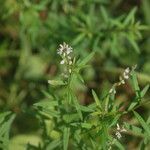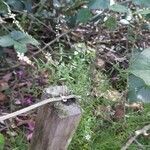Herbs annual, erect, 10-50 cm tall. Stems terete, mostly much branched, glandular pubescent. Leaves alternate, subsessile, lowest 4 or 5 often in pseudowhorls; leaf blade lanceolate to linear-lanceolate, 5-20 × 1-4 mm, 1-veined, lateral veins absent, base attenuate, margin entire, apex acute. Racemes terminal or opposite to leaves, 2-15 cm. Pedicel 0.5-1 mm; basal bracteoles caducous, lanceolate, apex acute. Sepals 5; outer sepals 3, ± elliptic, apex obtuse; inner sepals 2, purple, petaloid, elliptic-oblong, ca. 2 mm, 3-veined. Petals 3, white or violet; lateral petals narrowly ovate-lanceolate, attenuate to apex; keel apex with multifid appendages. Stamens 8, forming an open staminal sheath glabrous inside and split at top into 8 very short free filaments. Ovary obovoid to nearly globose; style straight, 1.5-2 × as long as ovary, apex expanded into an oblique broad cup, upper portion of which ends in tuft of hair; stigma at base of cup. Capsule oblong, ca. 2 mm, not winged, apex notched, glabrous. Seeds black, oblong, densely white pubescent; strophiole small, with 2 membranous appendages.
Annual, erect, mostly much-branched herb, up to 50 cm high. Stem terete, set with numerous small shortly stalked glands. Leaves lanceolate to linear-lanceolate, 5-20 by 1-4 mm, shortly petioled, acute, margin slightly recurved, (sub)glabrous, l-nerved, the lowest ones in one or more pseudowhorls of 4-5. Racemes all terminal, 2-15 cm long. Bracts and bracteoles early caducous. Flowers whitish or often purple tinged, 1.5-2 mm long, glabrous. Sepals lanceolate, obtuse, the alae weakly 3-nerved. Upper petals lanceolate; keel not auriculate, with 2 ± 6-fid appendages. Filaments free for ± 1/8. Ovary ± orbicular; style straight to near apex, there curved and strongly widened in an asymmetrical, wide cup, terminally with a hair tuft, diametrically opposed to this with the stigmatic lobe. Capsule somewhat longer than the alae, ± elliptic, c. 2 mm long, slightly notched, not winged. Seeds oblong, at micropylar side with a one-sided, deeply 2-fid aril, black, hairy.
Annual herb, erect with many ascending branches, 10–50 cm high; indumentum hispidulous on stems and/or minutely glandular-hairy. Leaves ± sessile, narrowly elliptic, 2–5 mm long, 6–20 mm wide; apex acute, mucro c. 0.3 mm long. Inflorescence a terminal or leaf-opposed raceme up to 60 mm long, exceeding the leaves. Pedicel
A herb. It grows each year from seed. It grows 10-50 cm tall.








